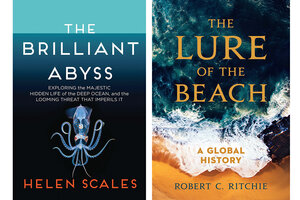Two books to make you think differently about the ocean and the beach
“The Brilliant Abyss” and “The Lure of the Beach” urge action to safeguard the world’s oceans and coastlines – along with the animal life found there.

"The Brilliant Abyss: Exploring the Majestic Hidden Life of the Deep Ocean, and the Looming Threat That Imperils It" by Helen Scales, 288 pp. and "The Lure of the Beach:
A Global History" by Robert C. Ritchie, 344 pp.
Atlantic Monthly Press and University of California Press
The Oscar-winning documentary “My Octopus Teacher” chronicles the unlikely friendship between a South African naturalist and an octopus. The film is a touching meditation on man and mollusk. It’s also a celebration of the ocean’s strange beauty. So too is Helen Scales’ “The Brilliant Abyss: Exploring the Majestic Hidden Life of the Deep Ocean and the Looming Threat That Imperils It,” an exploration of the deep sea’s biodiversity and the threats it faces.
Scales, a British marine biologist, begins by outlining the gargantuan scope: “On average,” she writes, “the oceans are around 12,500 feet deep, or close to two and a half miles.” The ridges of the deep seabed form a mountain range running 34,000 miles. At the deepest parts of the ocean, tectonic plates collide at subduction zones, where “old seafloor is dragged down into the earth’s molten interior, to be melted and recycled.”
The author lucidly explains not only the geological contours of the deep but also the animals that inhabit it. Sperm whales, we learn, can slow their heart rate to five beats a minute during dives, allowing them to slow the depletion of oxygen reserves. Scales introduces us to the pig’s rump worm, which, when gently prodded, “glows bright blue” and “squirts a shower of green glowing particles.”
Global warming seems to be disrupting the ocean’s circulation system, in which dense, cold seawater sinks to the ocean’s deepest reaches before warming and rising near the equator. Scales writes that one-third of humanity’s carbon emissions end up in the ocean, “saving the earth from an unthinkably swift and catastrophic version of the climate crisis.”
Scales catalogs a number of threats that menace oceans. She raises the alarm over the practice of deep-sea trawling, paying particular attention to the fate of the orange roughy, a fish that trawlers have coveted in substantial numbers. From 1945 to 2009, Scales writes, the amount of plastic falling to the seabed doubled every 15 years. Munitions and nerve agents from World War II are scattered throughout the ocean; Scales notes that blackbelly rosefish and European conger eel off the Italian coast have been found to contain high levels of arsenic, a residue of the chemical agent lewisite.
“As soon as you stop thinking about it,” Scales writes, “the deep can so easily vanish out of mind.” And yet, she continues, “this hidden place reaches into our daily lives and makes vital things happen without our knowing.”
Scales bids us to think of the deep not merely as a place to exploit for resources, but as a wondrous abode that we are compelled to protect – a precious realm that we should all care about.
In “The Lure of the Beach: A Global History,” scholar Robert C. Ritchie takes us from abyss to sandy shores. His book is more a cultural history of beachgoing than a scientific survey, but like Scales, his subtext is looming ecological disaster.
Ritchie observes that from antiquity through the Victorian age, the beach held a strong association with vice. The Stoic philosopher Seneca was appalled by the Roman resort of Baiae on the Bay of Naples: “I left it the day after I reached it. ... Persons wandering drunk upon the beach, the riotous revelling of sailing parties, I need not witness it.” During the 19th century, British moralists lashed out at nude and mixed-gender bathing.
In his discussion of Britain’s early resorts, Ritchie unearths the old relic of the “bathing machine.” A woman was expected to wear a bathing costume that covered her entire body, and it was considered inappropriate for her to walk on the beach in a wet outfit that would cling to her figure. The bathing machine, which Ritchie describes as “a structure made of wood or canvas mounted on cart wheels,” was designed to keep women’s bodies out of sight. The device, in which the occupant could change in privacy into her bathing costume, would be wheeled into the water, after which she could swim and then change into dry clothes again before returning to land.
The railroad brought increasing numbers of visitors to the beach. New Jersey was among the first American states to consider tracks directly to the shore, and in 1863, a line was completed that could get Philadelphians to Cape May, New Jersey, in three hours. France’s Train Bleu began service in 1886, shuttling travelers from Calais and Paris to the Riviera.
“The Lure of the Beach” examines the pressures exerted on beaches by the mass tourism of the 20th century. In its latter stages, the book delves into issues of privatization and equitable beach access, as well as the threat posed by climate change.
Ritchie’s concluding section is packed with sobering statistics. The author cites one estimate that a warming atmosphere could lead to a 3-foot rise in ocean levels by 2100. Beach lovers should take note: Unless current trends are fought back, sea rise “will imperil the beaches, and the nearly three-hundred-years-long history of beach resorts will be transformed in dramatic fashion.”

